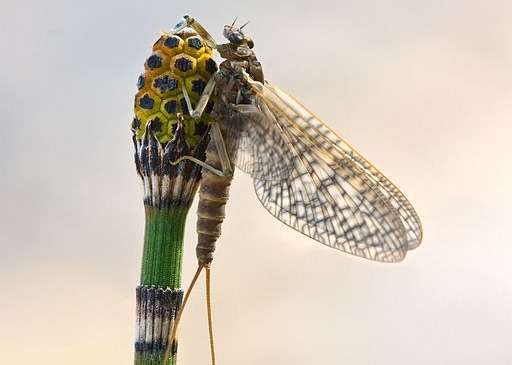
This is the time of year when those of us fishing the clear lakes of Michigan have to deal with a mayfly hatch.
Although it’s more prominent up here, it happens in the South, especially along the Coosa River. In fact, we encountered one in 2014 when we fished a tournament on Lake Chickamauga.
It’s a phenomenon that occurs throughout the summer in some places and can really affect what it takes to catch the fish.
Mayflies are just that – flying insects that emerge off the water’s surface, although most hatches occur in early June. They become so thick on our northern lakes that home and business owners around the water have to sweep up the bugs each day while the hatch is on.
The mayflies’ life cycle is fascinating. They start out as a legged bug that lives in the mud of lake and river bottoms. When early summer arrives, they transform to a nymph that rises to the surface during evening and nighttime hours, burst out of the skin to become a winged insect. They sit or flutter on the water for a few seconds before flying off.
All fish love to eat them, hence you’ll see dimpling on the surface during a calm morning or late evening – a sign fish are eating them.
Once the flies emerge, they leave behind “hulls” that will coat the lake surface.
Oddly enough, mayflies only live a day or two. For the next 24 or so hours, they will mate and quickly deposit their eggs on the water, where they sink into the mud and the process starts all over again.
Some anglers find these hatching periods are tough times to catch bass, but it just means you have to change your tactics. Those fish you were catching near the bottom before the hatch are now tuned into food sources on the surface.
In other words, it’s time to break out the topwaters.
My favorite is the small KVD splash popper in the clear minnow color. Translucent colors tend to work better because they best mimic the fly after it hatches.
Another good option is a pumpkin-colored tube or curl-tail grub that resembles the emerging wigglers before the transformation to a flying insect begins. I rig them on a 1/8- or 3/16-ounce leadhead and either swim the grub or snap the tube high off the bottom.
If it’s windy and you can’t see the flies or the fish slurping bugs off the top, try fishing a jerkbait in potential areas to help you locate the fish.
Another tip – especially on southern reservoirs or river systems – is to look for mayflies in shoreline bushes and trees. That’s one of the places they will mate and the fish seem to know that. Toss a topwater frog around overhanging branches and be ready. You can also shake the bush to get the bugs to fly and the fish around the brush will go crazy.
As always in bass fishing, it’s important to present lures that best resemble what the fish are feeding on. When the mayfly hatch begins, it’s time to change tactics and truly “match the hatch.”
And, of course, remember that it’s all about the attitude!
Kevin VanDam’s column appears weekly on Bassmaster.com. You can also find him on Facebook and Twitter.





